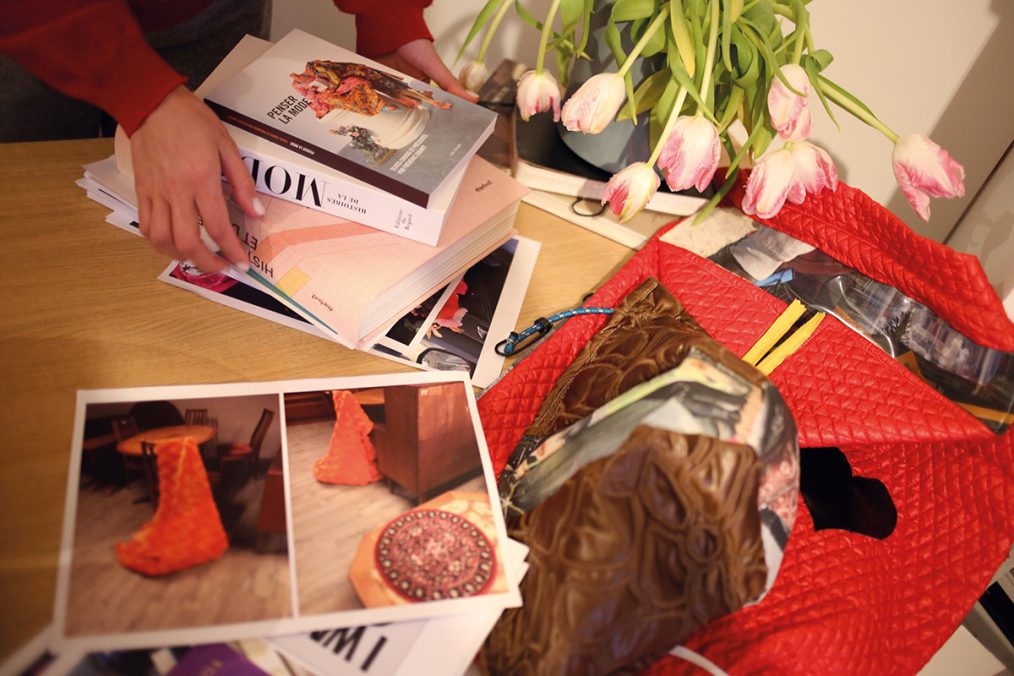
D.L: Chalisée Naamani, can you describe for us your present working situation?
Since I’ve been working from home with covid, I didn’t manage to find a studio yet. I work between my parents’ living room, with my mother helping me mostly with the sewing, and my apartment in Paris. It wasn’t easy every day with the curfew, because days passes without going out at all but in a way I stayed very focused on my work. I work a lot on my computer, productions period are always starting with a longue phase of research and composition of images on my softwares. So I don’t need to spread out, since everything first lives in my head and my computer. As my work progresses, I need to hang something or have a fabric, a prototype, an image in my apartment and this is the starting point of a fierce period of production – so a typical day in my home studio is me sitting at my table in front of the computer.
E.SH: It is striking the way you display your works. How are the decisions taken and how do the works emerge?
My ideas always emerge either from a mental vision or they start from an object, a fabric, or a quote, from which I will develop something to tell. I accumulate a lot of photos I take and screenshots which represents the pool of images I get inspired from. On one hand I have my phone as my main working tool and on the other hand notebooks I write in as my work develops. I write a lot, nothing honorable but it helps me a lot to think and build my ideas. Once all the pieces of the puzzle are put together, I do photoshop maquettes and sketches before physically forming the piece. And to be very honest, it may seem like a personal detail, but I also have a few essential keys to my process: I always have my mother, my brother, my best friend and my boyfriend who I ask advice at all stages of how my work grows and evolves.
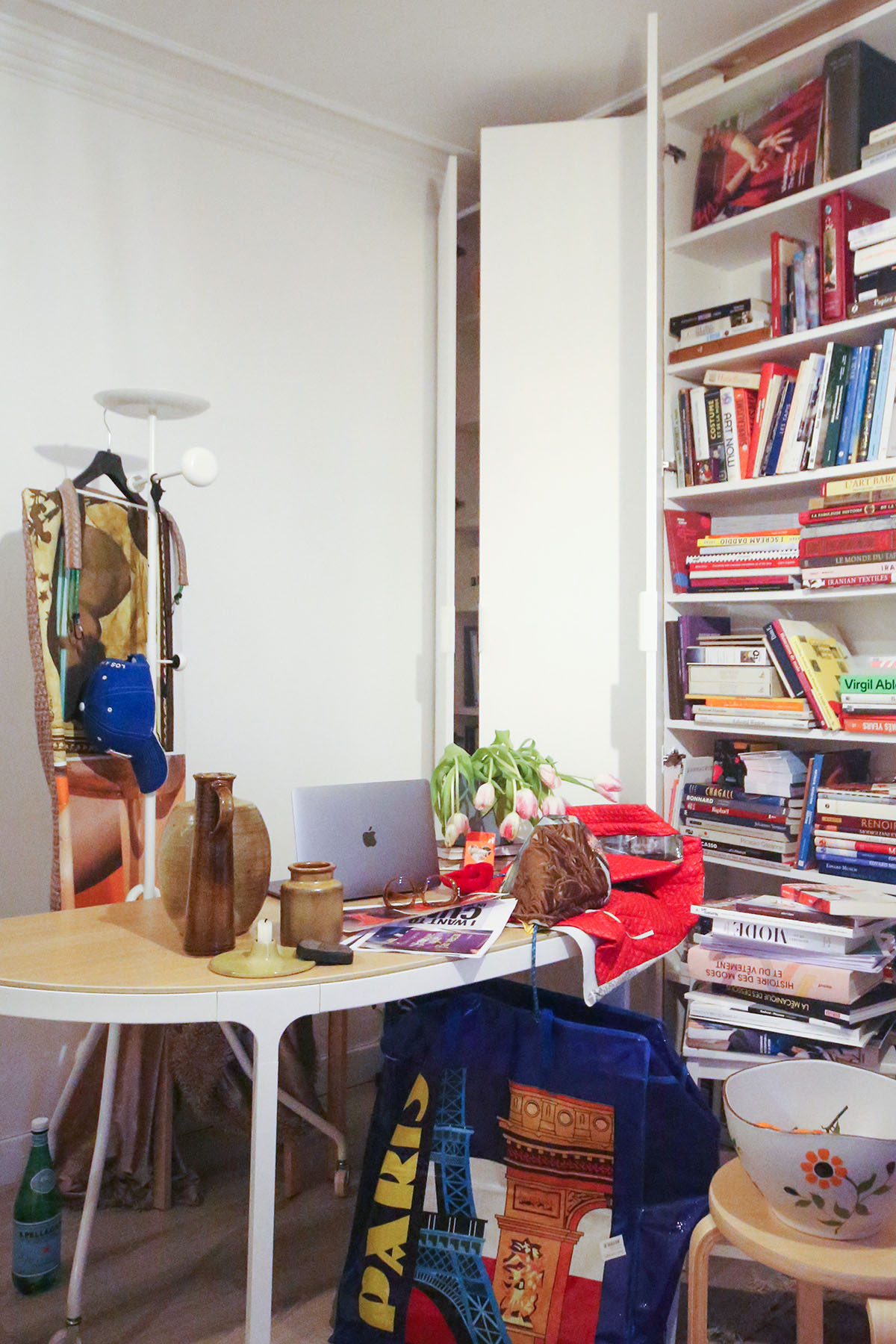
E.SH: You use in your work a lot of photography. I really like what Piero Bisello says in his text „Chalisée Naamani presents fashion“ – Alongside fashion, Chalisée Naamani’s painterly installations are full of photographs that are not photography. Can you elucidate a bit on the images on your work „Cape et gilet jaune“?
They are initially photographs but it is the way I use them that transform them. I think we don’t look at photography in the same way depending on how it is presented and that’s what interests me. I print images on fabrics that I integrate into garments that are part of an installation. There are multiple layers but everything for me remains an image, it’s a collage in three dimensions and the hanging system will influence the perception of these images. Since dressing up has always been the most natural expression of my sensibility, I naturally wanted us to be able to look at a garment as we look at a painting or photograph. In „Cape et gilet jaune“ I was exploring how political movements can use a piece of clothing to represent their political claims. It is a very effective way to identify a collective and it is a very strong identification tool for a movement. The yellow vest movement in France is a social movement of protest and the definition of a yellow vest is « high visibility clothing » – since at the base the yellow vest is a safety garment and is intended to improve visibility of a person moving along the edge of a roadway in a dangerous situation or on a construction site. The symbolism of the color yellow in Greek-Roman Antiquity it was a positive color, it symbolized wealth, fertility, light, heat, a beneficial color. It then gradually developed in the Middle Ages, it became the color of hypocrisy, betrayal, and that lasted until the 19th century when we repainted the house of traitors in yellow.
Conversely, the cloak covers the whole body and camouflages the person wearing it, I am thinking of the Harry Potter invisibility cloak for example, or the cape of a superhero: often a superhero has a secret identity in everyday life and the costume is there to protect the secret identity of the hero. It is high visibility clothing vs the invisibility cloak.
The image printed on the back of the Cape is a painting of „La vierge de la miséricorde » de Piero della Francesca. It is one of the iconographic variants of Christian painting of the theme of the Virgin Mary which signifies the benevolence and consolation of the Virgin Mary towards the humble and the weak. We see the Virgin offering protection through her cloak, which opens like a cape. On the front of the Cape, we see a representation of Saint-Augustin par Piero della Francesca. What interested me here are the little embroidered scenes on the edge of Augustine’s robe.
These scenes are carried over into the decorative textiles in the picture, in order to keep intact the illusion of a single, continuous space that Piero creates in the rest of his altarpiece and that flows between and around all its main panels.
D.L: What has been the most beautiful moments at the Beaux-Arts de Paris? How did it feel to be a student in the painting department and never apply painting in a classical sense?
My most beautiful moments at the Beaux-Arts de Paris were without hesitation my two graduation exhibitions. It’s so overwhelming, in the good sense, because we are deploying for the first time in a space of our own everything we have imagined, worked on for several years, in our own corner in the studio. It’s like a children’s playground for me and it is also a celebration moment that we share with family and friends, these are the most precious memories to me. I entered Jean-Michel Alberola’s studio because my work was very pictorial which did not necessarily translate into the very use of painting but for Jean- Michel, as for me, my presence in the studio was never a question. I have looked at painting a lot, more than photography actually, I have always been fascinated by painters, I think we all have a fantasy about painters with his palette, his brushes in front of his easel. I loved watching them prepare their stretcher, their canvas. Obviously I sometimes felt out of place with my classmates, but it was not a negative feeling. What was difficult, however, was the gap between their production time and mine. As I said, I work a lot on the computer, my place in the workshop was practically empty, I sometimes had images on my desk, or a piece of clothing hanging on the wall but we couldn’t quantify my production since it was not created the same way.
When a painter doubts, he still has his canvas in front of him, there is a physical connection, the object exists even if it is mutating while me when I am blocked, or that I doubt, if I am in this period of research, I only have my screen, my work does not yet exist physically and the feeling of emptiness is greater.
D.L: Where do you find the materials that you apply in your works?
It varies, it can come from a piece of clothing I wore, or a detail about it that I would like to explore by printing it so I can start physically working on it. By deconstructing the original piece I find a way to create new ones. The past of the product will be a part of the final piece, it’s a transformation.
D.L: What is the role of a calendar for you? How do you feel that your work is part of a such?
A calendar reminds me of advent calendars with chocolates inside. I am so honored to be part of yours and I thank you again for the opportunity. I couldn’t wait to know the month that was going to be illustrated by my work, and it’s May, spring! and since last May I became an aunty for the first time I am doubly delighted.
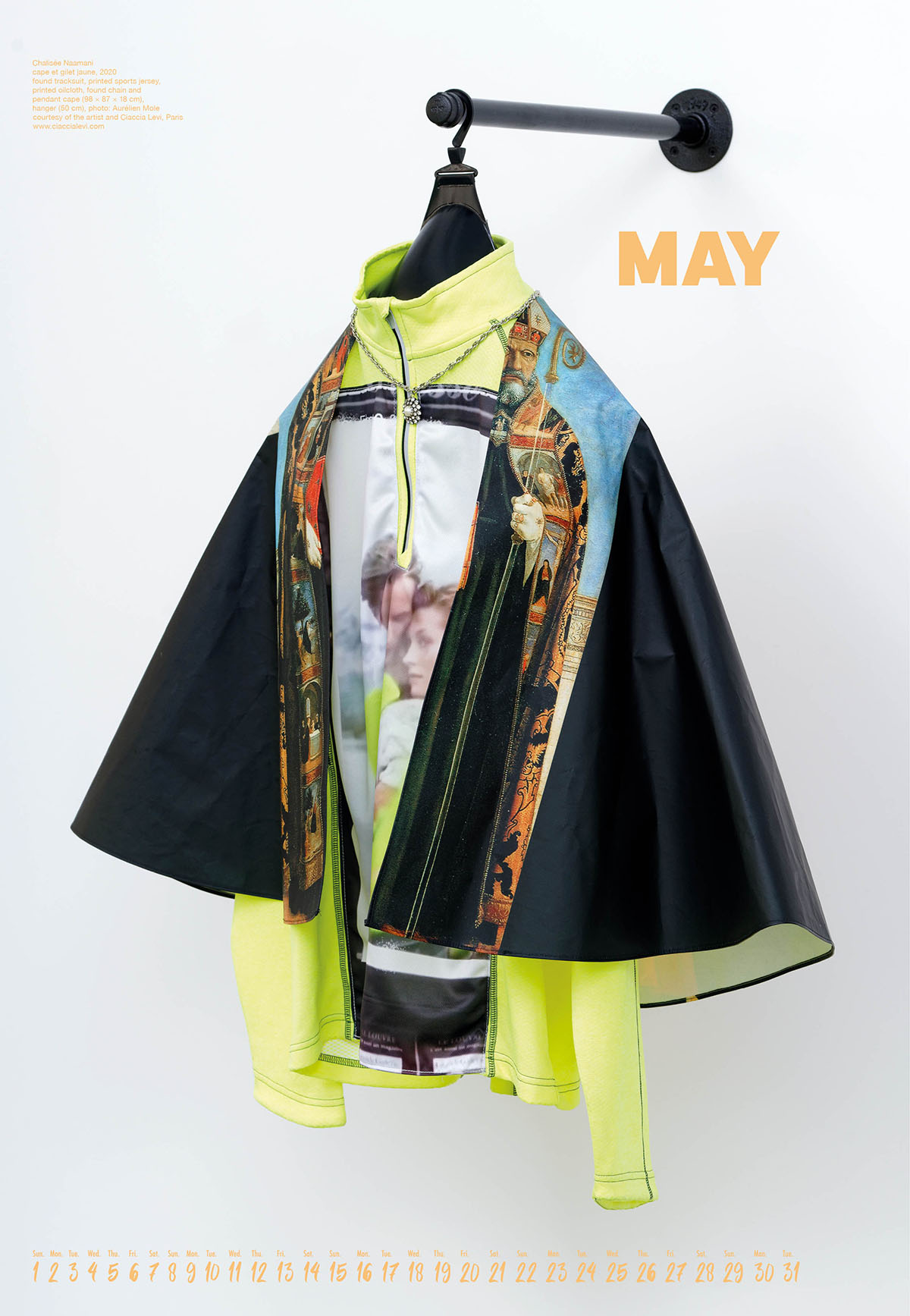
Chalisée Naamani, cape et gilet jaune, 2020 found tracksuit, printed sports jersey, printed oilcloth, found chain and pendant cape (98 × 87 × 18 cm), hanger (50 cm), photo: Aurélien Mole courtesy of the Artist and Ciaccia Levi | Calendar Photographer: Daniel Lichterwaldt 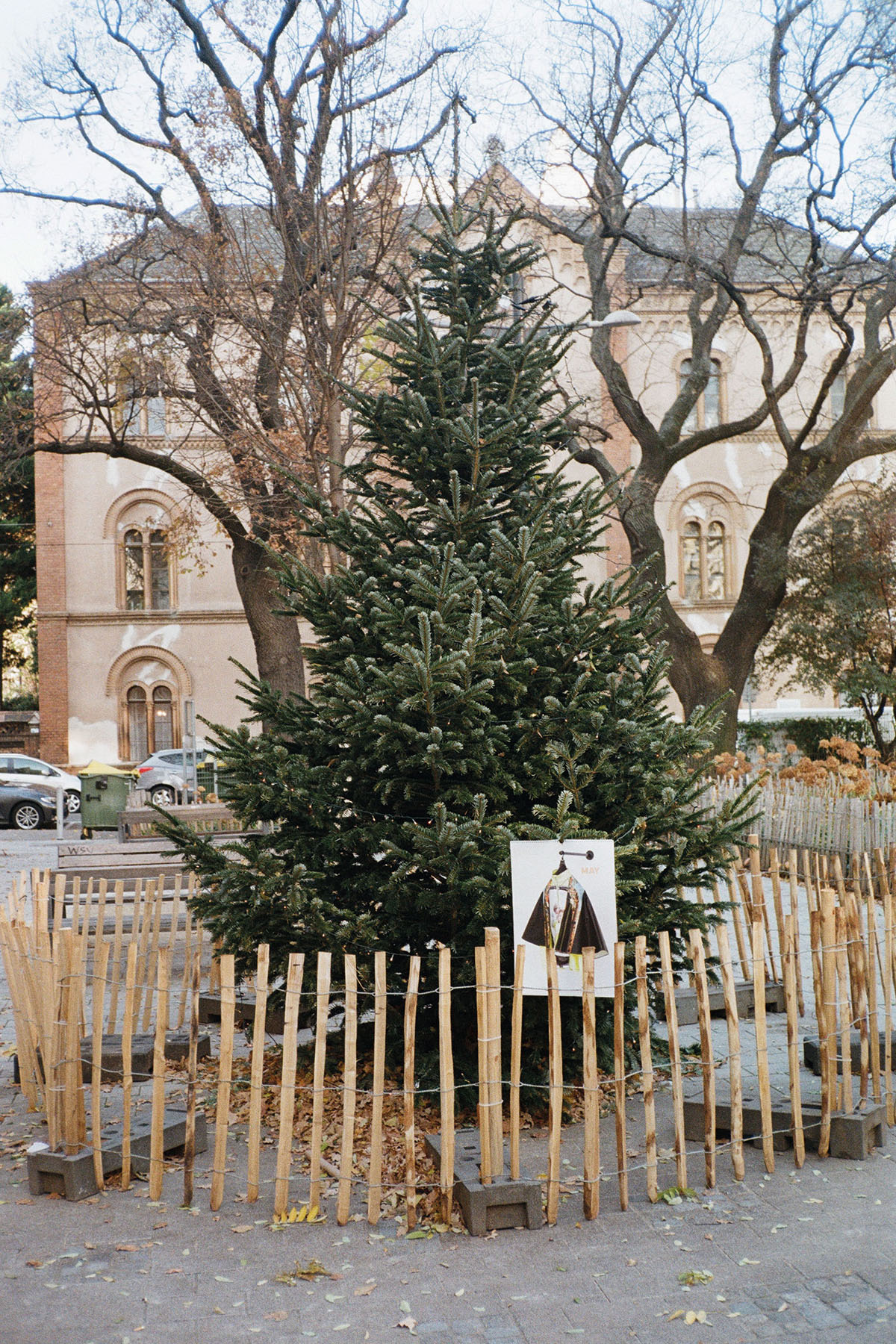
Chalisée Naamani, cape et gilet jaune, 2020 found tracksuit, printed sports jersey, printed oilcloth, found chain and pendant cape (98 × 87 × 18 cm), hanger (50 cm), photo: Aurélien Mole courtesy of the Artist and Ciaccia Levi | Calendar Photographer: Daniel Lichterwaldt
E.SH: Three books that are super dear at you.
This is a difficult question because I love to read and there are so many books that I cherish, my library is my temple. In the house of my dreams, I want a room for my books and a room for my clothes… My dream library would basically be from The Beauty & The Best and my dream dressing from Sex & The City. I would quote four books, two men, two women from four different periods:
• Divan, Hafez
• À la recherche de la base et du sommet, René Char
• Renaître, Susan Sontag
• Marx et la poupée, Maryam Madjidi
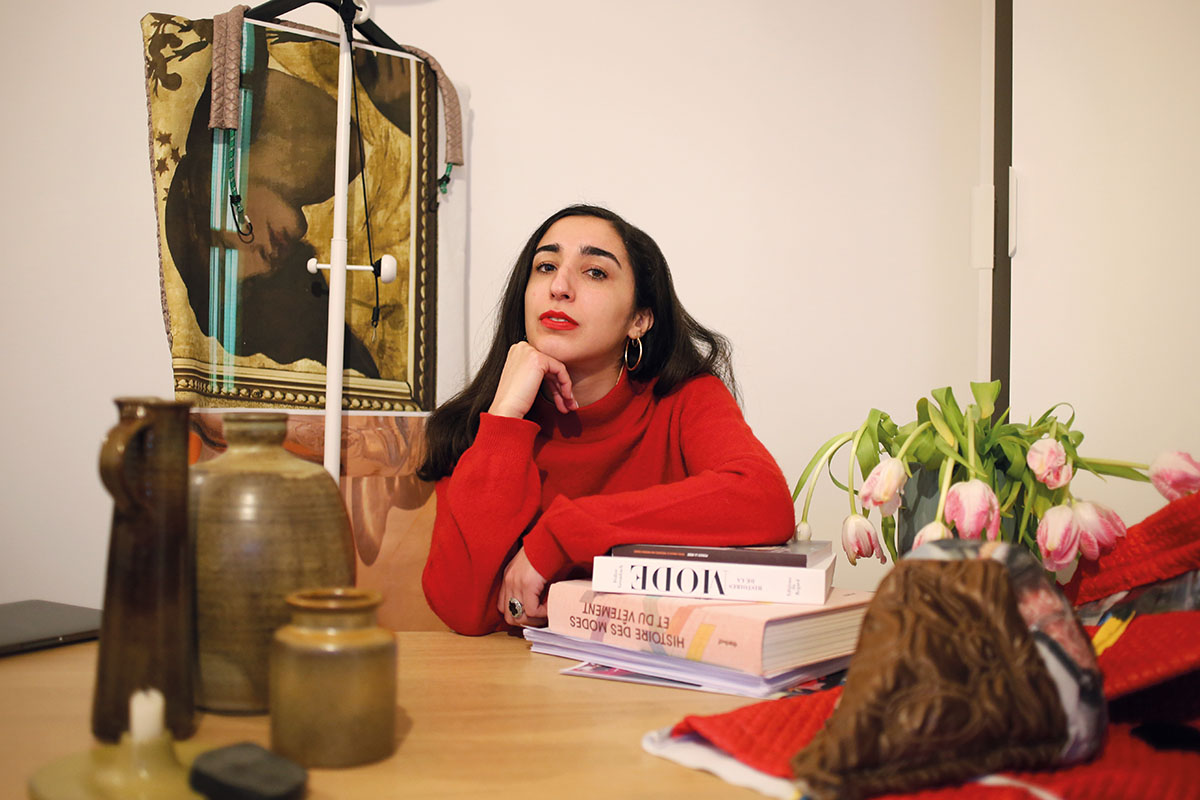
D.L: What are you currently working on?
Last October I experienced performing on stage for the first time and would love to explore this new line of work. I realize that it allows me to align different mediums at the same level and even more exhaustively, similar to how Cinema works. I am working on a new body of work, I have produced a lot for two years: I had my graduation exhibitions in October 2020 and my first solo show at Ciaccia Levi gallery in September 2021. I did not stop working and each time I proposed new pieces, produced especially for the occasion. So I still have a lot to do, I feel like I have to push my thinking even further and see how to make exist physically. I consider myself very lucky, I have two gallery owners who believe in my work and an entourage who supports me in everything I do. I cannot rest on my achievements, I still have a lot to prove and beyond that I have so much to tell. It can be stressful because I’m such a perfectionist and very demanding with myself but so it is so exciting because i’m passionate and so happy with what i do.
The „This Time Tomorrow“ Calendar 2022 is now available in the LNR Shop.
Chalisée Naamani – www.instagram.com/chaliseenaamani/
Address and Contact:
Ciaccia Levi Gallery
t34, rue de Turbigo, 75003 Paris
www.ciaccialevi.com
About the Interviewers: Erka Shalari (b.1988, Tirana) is a Vienna-based art author. She focuses on discovering independent young and emerging artists, unconventional exhibition spaces, and galleries that have deliberately broken new ground in their working methods. In this regard, she relies on unorthodox publishing practices, coupling these with a nonchalant manner of writing. The work oscillates between articles for magazines, exhibition texts and press releases.
Daniel Lichterwaldt founded 2019 the art magazine Les Nouveaux Riches.





